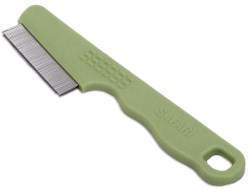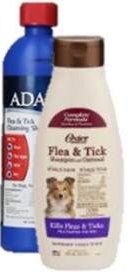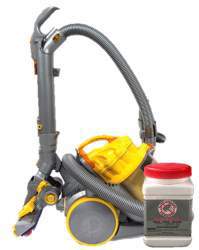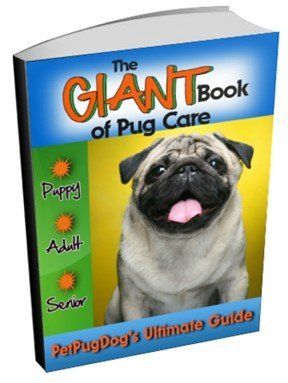When a Pug Has Fleas
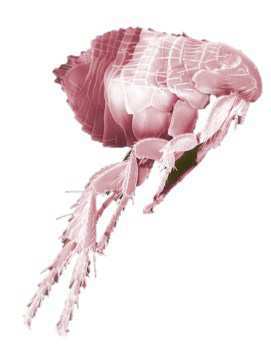
Overview
Most dogs will contend with fleas at least once in their lifetime. Fleas are an especially big problem if a dog is allergic to flea saliva. Many Pugs are more sensitive to flea bites as they age because older skin is drier and an aging immune system weaker.
Even if an owner cannot fathom how fleas may have attached themselves to their dog; it should be considered as a possible reason for intense scratching. All it takes for a Pug to have fleas is a visit to a vet, pet store, doggie park, etc. since a flea can jump from 1 dog to another from up to 6 feet away.
Signs and Symptoms of Fleas on a Pug
1) Scratching -
While fleas are extremely tiny, their bites can cause intense itching. Some dogs are allergic to the flea saliva that comes into contact with the skin as the insect nibbles to feast on a dog's blood, which exasperates itching even more.
Pugs may scratch their ears or any other part of the body. This may be done with the paws, but for areas that are hard to reach a Pug may rub a body part onto a surface such as flooring or bedding. He may also chew at itchy areas - usually the paws.
2) Irritated skin and/or fur loss
- Since fleas reproduce so quickly, a dog can rapidly have a huge infestation and for those that are allergic to the insect's saliva just one bite can cause such deep itching that there is hair loss as the Pug gnaws his body - most often the paws since these are easily accessible.
3) Very tiny dark specks.
Fleas do jump but they are wingless and therefore cannot fly. For this reason, you will not see a swarm of fleas circling a dog. If you take a close look, particularly on areas of your Pug that he/she hasn't been able to scratch, such as the tail and back, you'll typically see tiny black dots that are about the size of specks of finely ground pepper.
These may be brown or black. If you swipe some off with a white paper towel, fold it over and squeeze, you may see tiny red specks of blood.
Why Fleas are So Hard to Kill
Fleas are resilient and prolific. They like a temperate, moist climate best, but they can go into a dormant state for as much as a year, waiting until conditions for survival and reproduction are more favorable. They live (or lie dormant) both indoors and out in carpets, furniture, bedding, floor and wall joints, indoor plants, gardens, and yards. They'll infest the car too, if your Pug has been in it while fleas were attached to him.
Depending on how long your Pug has been infested, there can be several hundred to several thousand fleas on the coat. A typical full-out flea infestation on a dog will consist of roughly 4000 fleas.
These insects are so tiny, with 4 different life cycles that essentially a dog with fleas will be the host of a bustling and active civilization of insects; most of which is not seen by owners.
There will always be 4 things on a Pug with fleas:
1- The adult fleas -
These feed off of the blood of the puppy or dog and are what cause the majority of the itching.
2- Eggs -
Just one female adult flea can lay 50 eggs per day. Most will fall off the dog and settle into bedding, carpeting and more
.
3- Larvae -
When the eggs hatch, larvae emerge. After 5 to 20 days, they spin tiny cocoons.
4- Pupae -
While inside the cocoons, the fleas are referred to as pupae. They spend anywhere from 3 days to 1 year inside, emerging as adult fleas when conditions are ripe.
Note: For every flea you see, there are statistically at least 100 others in various stages of reproduction.
Your 3-Point Plan of Attack to Get Rid of Fleas on Your Pug:
- Remove all of the fleas, eggs, larvae and pupae on your dog and any other pets that live with you
- Thoroughly eradicate all four stages of fleas in your home
- Attack the fleas in all stages in the yard, garden, and car
The advertising literature for some flea control products makes it sound as though your problem will be solved by using just one method of flea control. One method alone usually will not work. Use this three-part plan of attack; It's the best way to achieve good results.
1. Treat Fleas on Your Pug
You'll want to use 2 products for this:
- A flea comb - both before and after the flea baths
- Flea shampoo - this will serve to treat the entire body and reach deep into the Pug's coat
The Comb -
You'll want to choose a quality comb with a sturdy double row design that can handle the dense coat of the Pug. Going over the coat multiple times using a flea comb will help remove both fleas, any eggs, larvae and pupae.
Eggs are super tiny and larvae are almost transparent; so when you use the comb (and shampoo) you will usually only visibly see the adult fleas which will look like black specks.
How to use a flea comb on a Pug:
1. Go slowly over every area of the coat
2. Comb in the direction of the fur growth
3. After each stroke, dip the comb in a container of a soapy water (you can use your Pug's normal shampoo to make this mixture)
4. Take your time to carefully go over all areas of the head since it will not be possible to shampoo these spots
The shampoo -
While the comb will get some of the fleas, you'll need to bathe your Pug in a quality flea shampoo that is also gentle to the skin and coat. Be careful about what you use since any harsh products will irritate already sensitive skin that has been ravaged by the bites.
Look for flea shampoos that are oatmeal based and also free of dyes, alcohol and parabens (these are preservatives put into many shampoos and products that a Pug can have a negative reaction to).
How to bathe a Pug in flea shampoo:
1, Fill the tub with luke warm water.
2. Soak the Pug's neck area first.
3. Lather this area all the way around the entire neck and scrub well. The goal is to form a barrier so that fleas from the rest of the body do not scurry up to the Pug's face.
4. Now work your way down the rest of your Pug's body, using lots of shampoo, enough water to keep it sudsy and massaging deeply to reach down into the dense coat. Be sure to get all areas including the genital area, tail and belly.
5. You will not shampoo/scrub the face because you do not want the soap to get into your Pug's eyes, nostrils and/or mouth. Since fleas love to live on ear flaps, Use pieces of gauze dipped into the shampoo to wipe the inner ears - not going too deep - and again with just gauze dipped in water.
6. Rinse your Pug extremely well - you should see dead fleas in the water. When you think you've rinsed enough, do it one more time.
7. Pat (not rub) your Pug dry and go over the coat again with the comb - particularly on the face since it is not possible to shampoo that area.
2. Treat the House
Using both a proper flea comb and a good flea shampoo will only work if you eradicate the fleas and all stages of those fleas that are in the house.
Most fleas spend most of their time OFF your Pug, jumping on just long enough for a meal. The rest of the time they live somewhere in the environment. They will be in the crevices of furniture, on sheets and bedding, in the rugs and carpeting and in every room of the house that your Pug has been in.
How to Get Rid of the Fleas in the House
1. Wash everything that is washable (cushions, sheets, blankets, pillow coverings, clothes, etc.) in hot water if possible and dry on a hot setting.
2. Vacuum everything you can - carpets, floors, chairs, sofas, beds, curtains, etc. This will be much more effective if you use a quality non-toxic powder that is first sprinkled down.
3. Spray the house down, preferably with a chemical free products. Those with peppermint oil and clove extract can effectively kill fleas and eggs without exposing your Pug to harsh toxins over household surfaces.
4. It may be necessary to bomb the house - this will send a light mist into crevices that typical cleaning cannot reach. It's best to choose a product that lasts for at least 6 months after using as well as one that dries quickly (30 minutes to 1 hour).
Note:
If you use a traditional exterminator, ask about the chemicals they employ. "Precor" is in the IGR class and is considered fairly non-toxic. Pyrethrins and pyrethroids, though somewhat toxic, are common and considered safe when properly applied. Organophosphates are also safe as long as you don't have exposure to them while they are still wet.
Safe and effective application depends a great deal on the professional doing the job. Be sure the person or company is experienced and has a good track record. You can find ratings and reviews on Yelp for local companies.
3. Attack Fleas in the Yard, Garden, and Car
There are many choices for do-it-yourselfers to apply to the yard and garden. A class of substances called "wettable powders" can be used effectively. Suspend Sc Insecticide is an example of a 75% Deltamethrin spray-pesticide that works well.
One problem with these pesticides, however, is that they don't discriminate among insects, and will be as lethal to ladybugs as they are to fleas. In addition, this is a strong insecticide that will leave residue.
There are some non-toxic alternatives to use in your yard that are very safe for dogs. Diatomaceous Earth is a drying agent that creates an inhospitable environment for fleas.
It is actually food grade, which means that while it is helping to kill fleas (and even some types so parasitic worms) it is technically safe for human or animal consumption - this means that after applying this, you don't have to worry about your Pug being outside.
You can spray or "bomb" your car yourself; however, if you don't ventilate the car adequately afterwards, exposure to the poisons in these preparations can be dangerous.
Try vacuuming thoroughly first ,using a good flea powder. Then use diatomaceous earth on the carpets and upholstery inside the car. Leave it on overnight, and vacuum again before using the car.
Consider a professional to do your yard, garden, and car at the same time as the interior of your home is being treated.
Protect Your Pug with Flea Control to Prevent Future Infestations
Even with flea prevention, a dog can still get fleas. Factors such as how many jump onto his coat, along with whether or not the treatment is waning off come into play.
However, using a repellent will greatly reduce the odds of fleas attaching to your puppy or dog.
First check with your Pug’s veterinarian to see if your dog is on medication or has a health condition
that would be compromised by using a particular flea control method. The best flea control also depends on age; one that may be right for a younger dog in a different state of health may not be right for a senior Pug.
Why You May want to Consider No-Chemical Protection
The Pug breed can have sensitivity to the chemicals that found in flea protection agents. A bad reaction can cause itching, rash, and even breathing issues.
While some all-natural repellents work great (see below), if your Pug needs something a bit stronger, Advantage is one that often tolerated well by small dogs.
It is not recommended to use flea collars with insecticide content. They are not very effective and can be harmful to your Pug. What some people do, however is place a flea collar inside the bag or filter area of vacuum cleaner. There it will kill any fleas you vacuum up around the house. When it comes to ultrasonic flea collars, we've heard they don't work.
The best flea control for Pug dogs is one that is organic and holistic yet effective in repelling fleas. You'll want a natural product that kills fleas no matter which stage of the life cycle they are in. Quality natural sprays are usually applied with a light mist each day. Adding this 1 to 2 minute grooming task to your day is often worth it to keep chemicals from your Pug puppy or dog.


